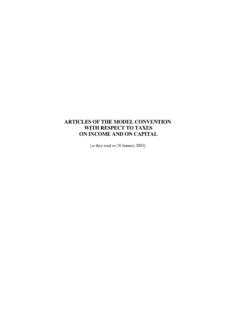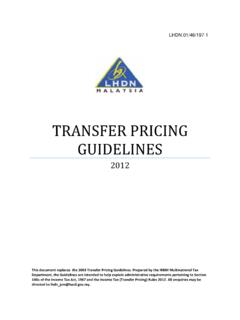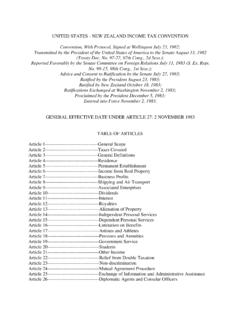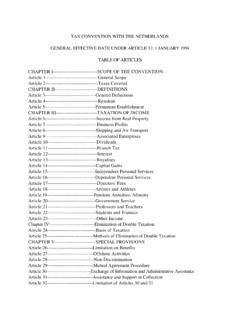Transcription of TAX CONVENTION WITH IRELAND GENERAL EFFECTIVE …
1 TAX CONVENTION with IRELANDGENERAL EFFECTIVE DATE UNDER ARTICLE 29: 1 JANUARY 1998 TABLE OF ARTICLESA rticle 1---------------------------------Genera l ScopeArticle 2 --------------------------------Taxes CoveredArticle 3 -------------------------------- GENERAL DefinitionsArticle 4 --------------------------------Residenc eArticle 5 --------------------------------Permanen t EstablishmentArticle 6 -------------------------------- income from Removable (Real Property)Article 7 --------------------------------Business ProfitsArticle 8 --------------------------------Shipping and Air TransportArticle 9 --------------------------------Associat ed EnterprisesArticle 10 -------------------------------Dividends Article 11 -------------------------------InterestA rticle 12 -------------------------------Royalties Article 13 ------------------------------- capital GainsArticle 14--------------------------------Indepe ndent Personal ServicesArticle 15 -------------------------------Dependent Personal ServicesArticle 16 -------------------------------Directors FeesArticle 17 -------------------------------Artistes and SportsmenArticle 18
2 -------------------------------Pensions, Social Security, Annuities, Alimony and Child SupportArticle 19 ------------------------------Government ServiceArticle 20 ------------------------------Students and TraineesArticle 21 ------------------------------Offshore Exploration and Exploitation ActivitiesArticle 22 ------------------------------Other IncomeArticle 23 ------------------------------Limitation on BenefitsArticle 24 ------------------------------Relief from Double TaxationArticle 25 ------------------------------Non-Discri minationArticle 26 ------------------------------Mutual Agreement ProcedureArticle 27 ------------------------------Exchange of Information and Administrative AssistanceArticle 28
3 ------------------------------Diplomatic Agents and Consular OfficersArticle 29 ------------------------------Entry into ForceArticle 30 ------------------------------Terminatio nProtocol --------------------------------of 28 July, 1997 Notes of Exchange -------------------of 28 July, 1997 Letter of Submittal--------------------of 19 August, 1997 Letter of Transmittal------------------of 24 September, 1997 The Saving Clause ------------------Paragraph 4 of Article 1 MESSAGEFROMTHE PRESIDENT OF THE UNITED STATESTRANSMITTINGCONVENTION BETWEEN THE GOVERNMENT OF THE UNITEDSTATES OF AMERICA AND THE GOVERNMENT OF IRELAND FORTHE AVOIDANCE OF DOUBLE TAXATION AND THE PREVENTIONOF FISCAL EVASION with RESPECT TO TAXES ON income ANDCAPITAL GAINS, SIGNED AT DUBLIN ON JULY 28, 1997, TOGETHERWITH A PROTOCOL AND EXCHANGE OF NOTES DONE ON THE SAME DATELETTER OF SUBMITTALDEPARTMENT OF STATE,Washington, August 19, 1997.
4 THE PRESIDENT: I have the honor to submit to you, with a view to its transmission to the Senatefor advice and consent to ratification, the CONVENTION Between the Government of IRELAND for theAvoidance of Double Taxation and the Prevention of Fiscal Evasion with Respect to Taxes on Incomeand capital Gains, signed at Dublin on July 28, 1997, ("the CONVENTION ") together with a Protocol andan exchange of notes done on the same date, which, in each case provides binding interpretations andunderstandings concerning the application of the CONVENTION . This CONVENTION will replace the existing CONVENTION Between the Government of the United Statesof America and the Government of IRELAND for the Avoidance of Double Taxation and the prevention ofFiscal Evasion with Respect to Taxes on income signed at Dublin on September 13, 1949.
5 The newConvention maintains many provisions of the existing CONVENTION , but it also provides certain additionalbenefits and updates the text to reflect current tax treaty policies. This CONVENTION is similar to the tax treaties between the United States and other OECD nations. Itprovides for maximum rates of tax to be applied to various types of income , protection from doubletaxation of income , exchange of information, and contains rules making its benefits unavailable topersons that are engaged in treaty shopping. Like other tax conventions, this CONVENTION provides rules specifying when income that arisesin one of the countries and is attributable to residents of the other country may be taxed by the countryin which the income arises (the "source" country).
6 In most respects, the rates under the new Conventionare the same as those in many recent tax treaties with OECD countries. The maximum rates of tax that may be imposed on dividend and royalty income are generally thesame as in the current treaty. Pursuant to Article 10, dividends from direct investments aresubject to tax by the source country at a rate of five percent. The threshold criterion for directinvestment has been reduced from 95 percent ownership of the equity of a firm to ten percent consistentwith other modern treaties, in order to facilitate direct investment. Other dividends are generallytaxable at 15 percent. Under Article 12, royalties derived and beneficially owned by a resident of aContracting State are generally taxable only in that State.
7 As in the current CONVENTION , under Article 11 of the proposed CONVENTION , interest arising in oneContracting State and owned by a resident of the other Contracting State is exempt from taxation by thesource country. The restrictions on the taxation of royalty and interest income do not apply, however, ifthe beneficial owner of the income is a resident of one Contracting State who carries on business in theother Contracting State in which the income arises and the income is attributable to a permanentestablishment in that State. In that situation, the income is to be considered either business profit orincome from independent personal services. The maximum rates of withholding tax described in the preceding paragraphs are subject to thestandard anti-abuse rules for certain classes of investment income found in other tax treaties andagreements.
8 The taxation of capital gains, described in Article 13 of the CONVENTION , generally follows the rule ofrecent tax treaties as well as the OECD model . Gains on real property are taxable in the country inwhich the property is located, and gains from the sale of personal property are taxed only in the State ofresidence of the seller, unless attributable to a permanent establishment or fixed base in the other State. Article 7 of the new CONVENTION generally follows the standard rules for taxation by one country ofthe business profits of a resident of the other. The non-residence country's right to tax such profits isgenerally limited to cases in which the profits are attributable to a permanent establishment located inthat country.
9 The present CONVENTION grants taxing rights that are in some respects broader and in othersnarrower than those found in modern treaties. As do all recent treaties, this CONVENTION preserves the right of the United States to impose itsbranch profits tax in addition to the basic corporate tax on a branch's business (Article 7). This tax,which was introduced in 1986, is not addressed under the present treaty. Paragraph 4 of the Protocolalso accommodates a provision of the 1986 Tax Reform Act that attributes to a permanentestablishment income that is earned during the life of the permanent establishment but is deferred and notreceived until after the permanent establishment no longer exists.
10 Consistent with treaty policy, Article 8 of the new CONVENTION permits only the country ofresidence to tax profits from international carriage by ships or aircraft and income from the use,maintenance, or rental of containers used in international traffic. This reciprocal exemption also extendsto income from the rental of ships and aircraft if the rental income is incidental to income from theoperation of ships and aircraft in international traffic. Article 21 of the proposed CONVENTION provides special thresholds to determine when incomederived in connection with the offshore exploration for, and exploitation of, natural resources may betaxed in the source country. The GENERAL rule of Article 21 is that all exploitation activities give rise to apermanent establishment while exploration activities create a permanent establishment only if theycontinue for a period of 120 days in a twelve-month period.



















